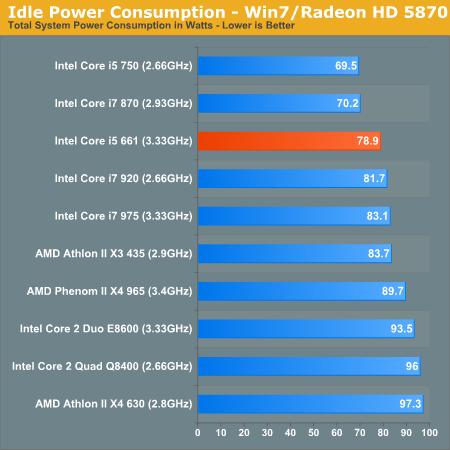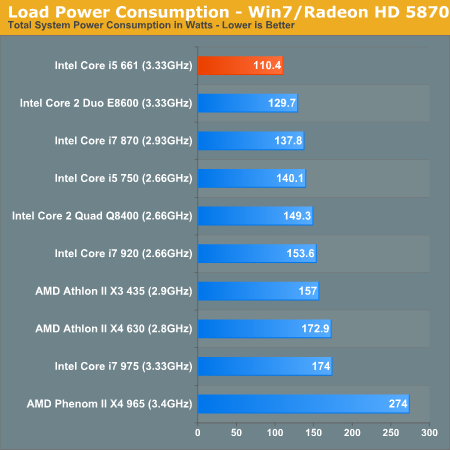The Clarkdale Review: Intel's Core i5 661, i3 540 & i3 530
by Anand Lal Shimpi on January 4, 2010 12:00 AM EST- Posted in
- CPUs
Power Consumption: Great but not as Good as Lynnfield
The biggest efficiency advantage Lynnfield held over Bloomfield was its extremely low idle power consumption. Clarkdale seems to ruin that thanks to its 45nm IMC/GPU on package. Idle power isn't bad, but noticeably worse than Lynnfield. Update: Many have pointed out that this may be a characteristic of our ASUS H57 motherboard, and that idle power is much more reasonable on Intel's H55 board. We're currently in Las Vegas for CES but upon our return we'll look into this further.

Load power is just dreamy though. This is ultimately what makes Clarkdale competitive. The i3s have the performance to compete with AMD's low-end triple and quad-core CPUs, but if they're anything like the i5 661 they have much better power characteristics than the competition.











93 Comments
View All Comments
Taft12 - Monday, January 4, 2010 - link
The parent's office PC's aren't bottlenecked by the OS - they're not bottlenecked PERIOD. They run modern productivity apps just fine and would gain little to no benefit from Core i3 (or Windows 7 for that matter).Paulman - Monday, January 4, 2010 - link
Those office PC's you mentioned aren't bottlenecked by the 2GB of RAM. But I wouldn't say that they aren't bottlenecked, "period". What they ARE bottlenecked by is disk I/O, I'm sure. Throw in a good SSD and you would notice quite a bit of speed improvement, and probably a noticeable difference between the 1.6GHz and 2.4GHz machines.The most annoying thing to me whenever I'm using my PC is seeing and hearing my laptop HDD thrash around when launching an app or what not, because everything is held up as a result. Yes, I know it's a laptop HDD, but desktop drives are pretty slow, too.
FlyTexas - Monday, January 4, 2010 - link
SSDs are indeed fast, and make the whole computer feel "snappier"...However, these office machines never shut down (they hibernate overnight). IE8, Word, Excel, and Acrobat are always open and always stay open. Once loaded in memory, the hard drive is hardly used.
I've looked at upgrading them to 3GB of RAM, but they aren't using what they have, so why bother? Most of them use right around 1GB of RAM most of the time.
Could we put 40GB SSDs in? Sure, they are about $130 at Newegg right now... Not the end of the world, until you multiply that times 24 machines. Not a minor expense.
FlyTexas - Monday, January 4, 2010 - link
That is so true. This the first time in a long time that the computers have been "fast enough" for everything we use them for.There was a time in 1993/1994 that we were in this position, running DOS 6 and Windows 3.1 on 486DX2/66 machines, where the move to the DX4/100 or Pentium saw no benefit until Windows 95 came out. I worked in small shop back then, and we demoed a Pentium 66 machine, and saw zero benefit over the 486DX2/66 machines, other than it cost twice as much.
Perhaps in 2002, the Athlon XP machines were "fast enough" for Windows XP and Office XP, that was a nice time as well in the business. A Pentium III 550mhz was my last personal Intel chip until 2006, when I got my first Core2Duo machine at home. I had to work with some Pentium 4s at work during that time, Intel really, REALLY dropped the ball with the Pentium 4, IMHO.
Oh well... I've been doing this a long time, I still remember 5.25" floppy drives, with NO hard drive and those ugly green monitors with Hercules graphics... :)
lowlight - Monday, January 4, 2010 - link
But the 45nm package on Westmere doesn't just carry the GPU. They also moved the PCI-E controller and Memory controller there. I guess the "CPU" is still technically 32nm, but compared to Nehalem, half the "CPU" actually resides on a 45nm package on the chip...You can see a diagram in this Clarkdale review: http://www.hardcoreware.net/intel-clarkdale-core-i...">http://www.hardcoreware.net/intel-clarkdale-core-i...
lowlight - Monday, January 4, 2010 - link
Guess I should have read the whole review... You guys picked it up too! Not many others did though ;)ilnot1 - Monday, January 4, 2010 - link
I swear I've scoured the pages but I don't see your Test System Setup Chart: how much RAM, which graphics card? If it is there and I missed it I wish you could delete posts.Spoelie - Monday, January 4, 2010 - link
It's on page 6I'd like to know the setup of each memory benchmark on page 2. What memory speeds and settings were used for the latency and bandwidth numbers?
Anand Lal Shimpi - Monday, January 4, 2010 - link
All of the CPUs used DDR3-1333 running at 7-7-7-20 timings for that test. I used Everest 1909 (I believe, I'm about 2300 miles away from my testbed right now :-P) and CPU-Z's latency tool to grab the data.Take care,
Anand
toyota - Monday, January 4, 2010 - link
I was looking for it too and its not there.